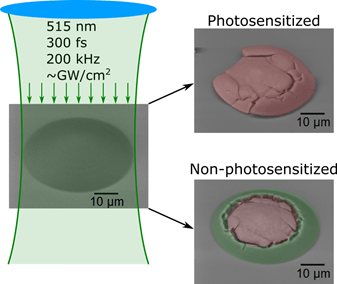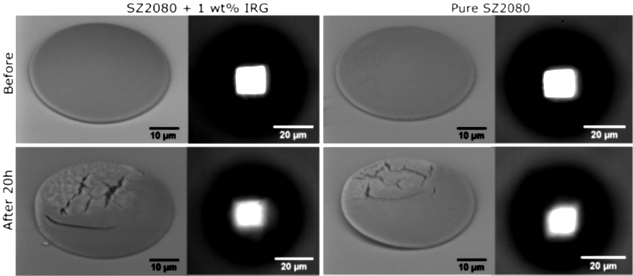
Glass-like free-form µ-optics for demanding applications in high power/harsh environment realized via laser 3D nanolithography.
The things that can be done with 3D printing never cease to amaze. To the casual observer with only a passing knowledge of the technology, it appears on the surface to be an interesting method of producing plastic odds and ends, and sometimes metal parts – but 3D printing is so much more, as anyone who follows the progression of the technology on a regular basis knows. The things it is capable of producing are often hard to wrap one’s mind around – especially when you look at 3D printing on the nanoscale.
A group of scientists from Lithuania, France and Australia are busy studying 3D printing on a very small scale. As a newly published paper entitled “Optically Clear and Resilient Free-Form μ-Optics 3D-Printed via Ultrafast Laser Lithography” explains, 3D printing is capable of creating functional objects that are impossible to produce via conventional manufacturing techniques, and structures at the miniature, micro- and nanoscales are no exception.
Dr. Mangirdas Malinauskas, Senior Research Fellow at Vilnius University’s Laser Nanopolymerization Lab and Associate Editor at Optics Express, explains to 3DPrint.com that he and his fellow researchers have found 3D printing to be effective in the production of miniature optical elements for micro-optical and nano-optical applications. Micro-optical refers to refractive components within a range of 10-100 µm, while nano-optical refers to diffractive components within the range of 0.1-10 µm. In other words, they’re all tiny, tiny lenses, used in highly specialized imaging technologies.
“It is assumed that this will be the key elements for the next generation of imaging, projecting, data transfer highly-integrated devices,” Dr. Malinauskas explains. “Today this requirement can be already fulfilled via ultrafast laser based stereolithography, which ensures accuracy and enables merging of micro-/nano-optical components into single monolith pieces. This is the bright side of the ultrafast laser 3D nanolithography, however the drawback is the polymer (plastic) optics are often referred being low quality in the sense of transparence and light induced damage at intense irradiations.”

Microlenses before and after 20 h exposition to a loose focusing of 515 nm 300 fs pulsed laser radiation and an image of an LED made by the lens. Degradation of a lateral light distribution in the focal plane can be seen both in the structural quality of the lenses and the degraded projected image. The microlenses of photosensitized resin are clearly distinguished to be more degraded.
He and the rest of the research team found that by tweaking the nanolithography process, these issues could be circumvented. Instead of using photo-resin, for instance, they managed to structure pure resin by using short, highly repetitive pulses, creating an avalanche-induced polymerization reaction to cross-link the material, rather than the more typical photopolymerization. By using this method, they were able to create micro- and nano-optical components that are transparent in the whole visual spectrum and near UV.
“More importantly, once being of crystal clarity such elements are highly resilient to optical damage even at a few GW/cm2 intensity (corresponding to order of ~1 mJ/cm2 at fs pulse regime and intricate surfaces),” continues Dr. Malinauskas. “This opens way to create highly resilient integrated glass-like optical free-form components for low-loss (telecommunication), high-power (non-linear optics), and optical micromanipulation including harsh environments (high temperatures and chemical solvents) applications. Alternative long lifetime of components is attractive for integrated/remote sensors as the signal can be filtered and transferred via widespread existing platforms such as optical fibers.”

Freeform 3D micro-optical elements fabricated by ultrafast laser 3D nanolithography: hybrid optical elements—aspheric and axicon lenses mounted directly on a tip of a single-mode optical fiber.
The technology, described in the paper as femtosecond 3D laser lithography (3DLL), holds a lot of promise for the 3D printing of nano- and micro-optics, including printing them directly onto optical fibers. In addition, the paper describes how the researchers used pyrolysis to remove organic SZ2080 from structures, shrinking them by up to 40% – meaning that the technology holds potential for downscaling photonic lattices and creating mechanically robust glass-ceramic microstructures.
You can access the full paper here. Dr. Malinauskas additionally references two further scientific papers in this research, which are available here and here. Discuss in the Nanoscale Optics forum at 3DPB.com.
[Images courtesy of Dr. Mangirdas Malinauskas, provided directly to 3DPrint.com]
Subscribe to Our Email Newsletter
Stay up-to-date on all the latest news from the 3D printing industry and receive information and offers from third party vendors.
You May Also Like
3D Printing Financials: Fathom Struggles in Financial Quicksand During Critical Transition
Facing a year of key transitions and financial pressures, Fathom (Nasdaq: FTHM) has filed its annual report for 2023 with the U.S. Securities and Exchange Commission (SEC). The document outlines...
Latest Earnings Overview for Australian 3D Printing Firms Titomic and AML3D
Australian 3D printing manufacturing firms Titomic (ASX: TTT) and AML3D (ASX: AL3) reported their financial results for the period from July to December 2023, marking the first half of their...
3D Printing Webinar and Event Roundup: April 7, 2024
Webinars and events in the 3D printing industry are picking back up this week! Sea-Air-Space is coming to Maryland, and SAE International is sponsoring a 3D Systems webinar about 3D...
3D Printing Financials: Unpacking Farsoon and BLT’s 2023 Performance
In the Chinese 3D printing industry, two companies, Farsoon (SHA: 688433) and Bright Laser Technologies, or BLT (SHA: 688333), have recently unveiled their full-year earnings for 2023. Farsoon reported increases...































